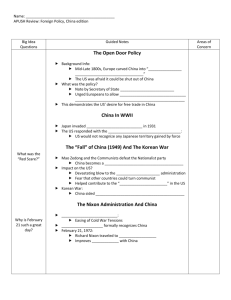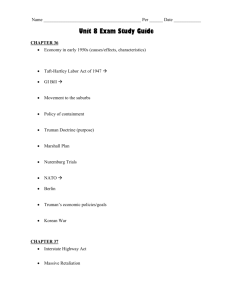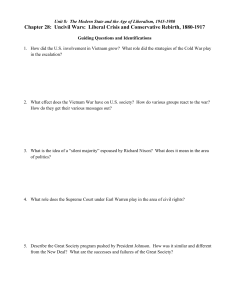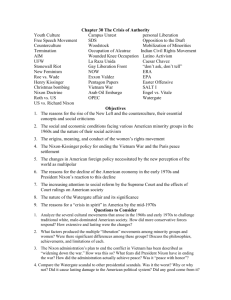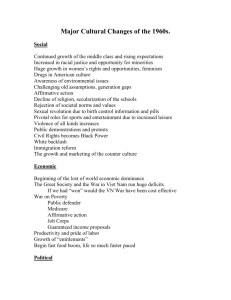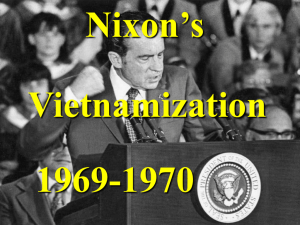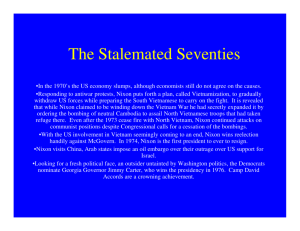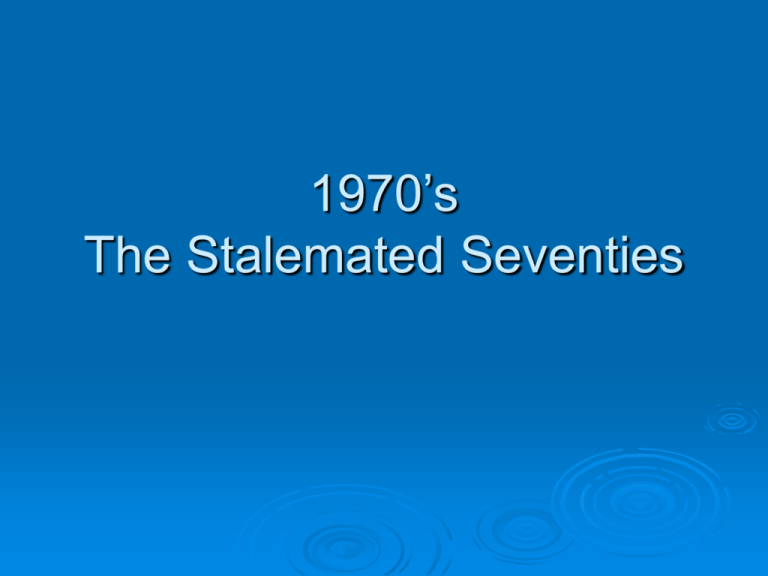
1970’s
The Stalemated Seventies
Economy
As the 1960’s came to a close and the 1970’s
started, the post-war economic boom started to
slow to a trickle.
25 years after WWII, in 50’s and 60’s productivity
rates more than doubled the standard of living
However, around 1970, productivity gains almost
vanished. For the whole decade, the productivity
rates increased the equivalent to one year in the
previous two decades.
At that rate, it would take 500 years to see another
doubling of the standard of living.
In addition, median income stagnated from roughly
1970-1990, and only reason for the absence of a
decline is dual income families (wives working too)
Median Family Income, 1970–2001
During the long post-World War II economic boom (from about 1950 to
1970), family incomes increased dramatically, but after 1970 “real,” or
inflation-adjusted, incomes stagnated. Prosperity in the late 1990s led to a
slight upward trend, though adjusted median family income began to
decline in the early years of the twenty-first century.
Sources: U.S. Census Bureau, Bureau of Labor Statistics, Statistical Abstract of the United States, 2003, and John J. McCusker,
“Comparing the Purchasing Power of Money in the United States (or Colonies) from 1665 to 2003,” Economic History Services, 2004.
Economy
Why a slump in productivity?
Not clear, but author suggests the following reasons:
• Increase of women and teenage workers, who did
not have long-term jobs and did not learn skills to
increase productivity
• Declining investment in new machinery
• Heavy costs of government regulation
• Shift from manufacturing to services (tougher to
improve productivity with services)
• Vietnam War and its costs to the government
(opportunity costs of investment in education, R +
D, science)
• Vietnam War and Welfare spending leads to crazy
inflation
• Gas Prices rising
Economy
Huge
culprit was inflation:
Too many dollars chasing too few goods,
means inflation.
With Defense Spending and Welfare, more
dollars in more Americans hands at same
time productivity fails to increase.
1968-1980, cost of living tripled. Longest
period of inflation and steepest in nation’s
history.
The Nixon Wave
During Richard Nixon’s
presidency, Americans
experienced the first
serious inflation since
the immediate postWorld War II years. The
inflationary surge grew
to tidal-wave
proportions by the late
1970s, when the
consumer price index
rose at an annual rate
of more than 10
percent.
New York Daily World
Economy
Other
issues:
After World War II, few to any competitors for
American steel, manufacturing, automobiles,
and electronics.
Little to no need to modernize or improve,
people bought your stuff without improving or
modernizing technology or management.
But in the 1970’s German and Japanese
products proved to be superior in quality
because they had modernized their
technology and management techniques
Nixon on Vietnam
Nixon’s 1968 Campaign promised an end
to the war: Peace with Honor
Vietnamization
Slowly withdraw 540,00 American troops
and pass responsibility
of their defense to South
Vietnamese (with American financial and
military
Nixon Doctrine
Basically, U.S would honor current
commitments, but in future wars
Asians and others would have
to fight their own wars without
the support of large bodies of
US ground troops
President Richard M. Nixon
Reversing Kennedy’s inaugural plea to “bear any burden,” Nixon told
Congress in February 1970, “America cannot--and will not--conceive
all the plans, design all the programs, execute all the decisions and
undertake all the defense of the free nations of the world.”
Constantine Manos/ Magnum Photos
Vietnam
By 1970
Draft policies exempted college students and men with
critical civilian skills
Longest conflict in American history
40,000 killed
250,000 wounded
So, troops were disproportionately poor and blacks served
disproportionately.
Drug abuse, alcoholism, mutiny, and sabotage created
low morale amongst soldiers.
Not knowing their enemy, trudging through the jungle
and swamps all took their toll
My Lai Massacre
U.S. troops massacred women and children in the village of My
Lai 9evidence of the demoralizing nature of the conflict)
Cold War?
Not for Some
This poignant cartoon reminds
its audience that while the
rhetoric of the day might have
been about a "Cold War," as
America pursued its anticommunist policies around the
world, some Americans were
paying a very real price.
The War at Home
Antiwar students clash with police in
Ann Arbor, Michigan, in 1970.
Portland Oregonian
Cambodia
Cambodia was used by Vietcong and North
Vietnamese as a springboard for troops,
weapons, and supplies
April 29, 1970, Nixon ordered US troops to clean
Cambodia of the Vietcong and North Vietnamese.
Most importantly, he did this without consulting
Congress.
Many respond in protest to eh escalation of the
war into Cambodia, especially without
congressional approval
Kent State (4 shot dead) and Jackson State (2 killed)
occur
“Pentagon Papers,”
1971
Former defense analyst Daniel Ellsberg
leaked govt. docs. regarding war efforts during
Johnson’s administration to the
New York Times.
Docs. Govt. misled Congress & Amer. People
regarding its intentions in Vietnam during mid-1960s.
Primary reason for fighting not to
eliminate communism, but to avoid
humiliating defeat.
New York Times v. United States (1971) *
Also, Congress repealed the Tonkin
Gulf Resolution to curtail Nixon’s power
Balancing Act
China
and Soviet
Union had a
contentious
relationship.
Nixon played
them off each
other to cool Cold
War tension and
get peace in
Vietnam
Ranan R. Lurie/ Cartoonnews International
Some
Chicken,
Some Egg,
1975
This cartoon pokes fun at Henry
Kissinger as a global
statesman. Serving first as
President Nixon’s national
security adviser and then as
secretary of state in the Nixon
and Ford administrations, the
German-born Kissinger brought
with him to Washington a
sophisticated--some said
cynical--view of the world honed
during his nearly two decades
as a political science professor
The Economist
at Harvard.
Nixon and Detente
In 1972, Nixon was the first president to visit
Communist China. Capped visit with the
Shanghai Communique, in which both nations
agreed to normalize their relations. U.S. also
accepted One-China policy
Next Nixon went to Moscow and played the
China card. Also knew that the Soviets needed
food supplies.
US agreed to sell 750 million in wheat, corn, and
other cereals.
SALT Treaty
US and USSR agreed to treaties on anti-ballistic
missile defense systems and also armsreductions negotiations (SALT-Strategic Arms
Limitation Talks).
Goal was to freeze long range nuclear missiles
for 5 years.
Important in curtailing the arms race, but even
though defensive systems forbidden, US still
wnet ahead with development of MIRV’s.
(designed to overcome any defense system by
overwhelming it)
Thus, Soviets did the same and built MIRV’s
By 1980’s, 16,000 Nuclear Warheads on each
side.
Changes on the Bench
Warren
Court
Chief Justice Earl Warren, following his
appointment in 1953, presided over a preiod
of judicial activism that ruled on cases that
drastically affected sexual freedom, the rights
of criminals, the practice of religion, civil
rights, and the structure of political
representation.
His Court’s decisions reflected deep concern
for the individual
Warren Cases
Griswold
Struck down state law that prohibited use of
contraceptives
Gideon
v. Connecticut (1965):
v Wainwright (1963)
All defendants in serious criminal cases had
right to counsel, regardless if they were poor
or not.
Escobedo
(1964) and Miranda
Right of the accused to remain silent and
enjoy other protections to the accused.
Warren Case
New York Times v Sullivan (1964)
Public figures can sue for libel only if they can prove
that malice motivated their defamers (hard to do).
Opens the door for criticism of public f\officials and
their private lives.
Engel v Vitale (1962) and Abington v Schempp
(1963)
Eliminate prayer and Bible readings at school.
Invoking First Amendment and separation of Church
and State
Warren Cases
Reynolds v Sims (1964)
Ruled against unfair representation in state
representatives. Used one man one vote theory and
cows do not count (basically, voting power in some
rural areas was 1000 times more than in
underrepresented urban settings.)
Nixon looked to change the make-up of the
bench and have a less meddlesome and activist
Supreme Court. By 1971, Nixon appointed 4
conservative justices. But Chief Justice Burger
not as conservative as he hoped (Roe v Wade)
Nixon and Domestic Policy
Nixon surprisingly expanded welfare and
entitlements programs:
Food Stamps, Medicaid, and Aid to Families with
Dependent Children all got more appropriations
In 1972, agreed to automatic Social Security cost-ofliving increases
Philadelphia Plan
• Construction unions to establish goals and timetables for the
hiring of black apprentices
• Later extended to all federal contractors, essentially
establishes a quota system for minorities and extends
Johnson’s affirmative action
• Griggs v Duke also eliminated intelligence tests. Basically,
Nixon and the court made it a requirement to hire minority
workers
Nixon and Domestic Policy
Two
new agencies developed too:
Environmental Protection Agency (EPA)
Occupational Health and Safety
Administration (OHSA)
• Both a by-product of the increased concern in
protecting the environment
1950 in LA air pollution control office established
1962: Silent Spring written by Rachel Carson, exposed
the poisonous effect of pesticides on nation.
• Clean Air Act of 1970 and Endangered Species Act
of 1973
Nixon and Domestic Policy
In
1971, in instituted a wage freeze and
price freeze for 90 days.
He also took the US off the Gold Standard,
effectively ending the agreement at Breton
Woods to stabilizing international
currencies.
Southern Strategy
To gain Southern votes, Nixon appointed
conservative Justices, soft pedaled civil rights,
and opposed school busing to achieve racial
balance.
1972 Election
Nixon
v George McGovern (South Dakota
Senator)
Vietnam was escalating in 72, despite
Nixon promising peace in 68.
McGovern promises to pull troops out
Nixon promises to draw back troops from
540,000 to 30,000.
Kissinger announces peace is at hand 12
days before election
The Ceasefire,
1973
Peace is at hand Kissinger, 1972
North Vietnam attacks South
Most Massive U.S. bombing commences
1973: Ceasefire signed between
U.S., South Vietnam, & North Vietnam
Peace with honor (President Nixon)
Presidential Election of 1972 (with electoral vote
by state)
Nixon buried McGovern in this election, but when his administration soon
thereafter began to sink in a swamp of scandals, bumper stickers appeared in
Boston proclaiming, “Don’t blame me, I’m from Massachusetts.”
Copyright (c) Houghton Mifflin Company. All Rights Reserved.
Cambodia and War Powers Act
U.S. Air
Force conducted 3500 aerial raids
in Cambodia
This shocked many Americans and they also
questioned the constitutionality of the act.
Especially since many of these bombings
occurred before official incursion in May 1970.
President and Congress confirmed Cambodia
neutrality the whole time, even though they
were bombing them.
Many Americans questioned what type of
representative government they had if war
was occurring without their knowledge.
Cambodia and War Powers Act
Even
after the cease-fire, Nixon continued
bombing of communist forces in
Cambodia.

